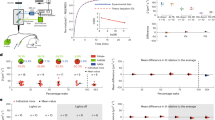Abstract
STEIN1 suggested, on the basis of the effects of amphetamine and other adrenergic drugs on self-stimulation behaviour, that the reinforcement feedback of the consequence of an action was mediated by a noradrenergic pathway in the region of the medial forebrain bundle. Noradrenergic and dopaminergic pathways in this region of the brain have been mapped by Ungerstedt2, and Crow3,4 has suggested that the gustatory and olfactory input to these pathways might fit them for a role in transmitting environmental feedback. Other evidence implicates the dopaminergic nigro-striatal pathway in memory function as well. Microstimulation in the pars compacta of the substantia nigra has been found to produce a memory impairment not found on stimulation of the surrounding nuclei5, lesions in the substantia nigra impair learning6,7 and pharmacological manipulation of the level of dopamine in the substantia nigra can impair learning and performance of cats in a delayed response task8. Crow9 has found that locus coeruleus lesions may completely abolish learning in a runway situation. This indicates the involvement of monoaminergic-containing neurones in memory function. 6-Hydroxydopamine produces a depletion of brain noradrenaline and dopamine when injected into the lateral ventricle of the rat brain10, and also a reduction in the activity of the biosynthetic enzyme tyrosine hydroxylase11 consistent with the morphological finding of acute degeneration of the nerve terminals12,13. Depletion of the monoaminergic neurones using 6-hydroxydopamine would therefore be predicted to impair learning behaviour, and has indeed been found to produce a transitory decrease in responding on a fixed-ratio schedule for water reward14. This, however, returned to normal within a few days. Conversely, an increase in responding on a variable interval schedule after 6-hydroxydopamine has been found15.
This is a preview of subscription content, access via your institution
Access options
Subscribe to this journal
Receive 51 print issues and online access
$199.00 per year
only $3.90 per issue
Buy this article
- Purchase on Springer Link
- Instant access to full article PDF
Prices may be subject to local taxes which are calculated during checkout
Similar content being viewed by others
References
Stein, L., in Animal Behaviour and Drug Action, Ciba Symposium, (J and A Churchill Ltd., London, 1964).
Ungerstedt, U., Acta physiol. scand. supplement, 367, 1 (1971).
Crow, T. J., Psychological Medicine, 2, 414 (1972).
Crow, T. J., ibid, 3, 1 (1973).
Routtenberg, A., and Holzman, N., Science, 181, 83 (1973).
Thompson, R., J. comp. physiol. Psychol., 69, (No. 4), Monograph (1969).
Mitcham, J. C., and Thomas, R. K., J. comp. physiol. Psychol., 81, 101 (1972).
Kitsikis, A., Roberge, A. G., and Frenette, G., Expl Brain Res., 15, 305 (1972).
Crow, T. J., Science, 181, 682 (1973).
Uretsky, N. J., and Iversen, L. L., Nature, 221, 557 (1969).
Uretsky, N. J., and Iversen, L. L., J. Neurochem., 17, 268 (1970).
Malmfors, T., and Sachs, C., Eur. J. Pharmac., 3, 89 (1968).
Thoenen, H., and Transer, J. P., Arch. Pharmac. exp. Path., 161, 271 (1968).
Schoenfeld, R., and Zigmond, R., Pharmacologist, 12, 157 (1970).
Schoenfeld, R., and Uretsky, N. J., Eur. J. Pharmac., 20, 357 (1972).
Breese, G. R., and Taylor, K. M., J. Pharmac. exp. Ther., 174, 413 (1970).
Morgan, M. J., A Study of Response Learning. (Ph.D. thesis, University of Cambridge, 1968).
Glowinski, J., and Iversen, L. L., J. Neurochem., 13, 655 (1966).
Hendry, I. A., and Iversen, L. L., Brain Res., 29, 159 (1971).
Uretsky, N. J., and Iversen, L. L., J. Neurochem, 17, 269 (1970).
Author information
Authors and Affiliations
Rights and permissions
About this article
Cite this article
MASON, S., IVERSEN, S. Learning impairment in rats after 6-hydroxydopamine-induced depletion of brain catecholamines. Nature 248, 697–698 (1974). https://doi.org/10.1038/248697a0
Received:
Revised:
Issue Date:
DOI: https://doi.org/10.1038/248697a0
This article is cited by
-
The use of extinction to investigate the nature of neuroleptic-induced avoidance deficits
Psychopharmacology (1980)
-
The effect of amitriptyline and mianserine (Org. GB94) on food motivated behaviour of rats trained in a runway: Possible correlation with biogenic amine concentration in the limbic system
Psychopharmacology (1979)
-
Effects of l-dihydroxyphenylalanine (l-Dopa) and d,l,5-hydroxytryptophan (d,l,5-HTP) on reserpine-induced amnesia
Psychopharmacology (1977)
-
Schizophrenia: A theory
Psychopharmacology (1976)
-
How the cerebellum could memorise movements
Nature (1975)
Comments
By submitting a comment you agree to abide by our Terms and Community Guidelines. If you find something abusive or that does not comply with our terms or guidelines please flag it as inappropriate.



